Flying With Trade Air on a Let L-410 Turbolet Across Croatia
In this review, we will take a Trade Air flight on a Let L-410 Turbolet across Croatia from Zagreb to Osijek, Pula and Split.
Croatia
Most of Europe’s flight routes aren’t too special, as they are simple direct flights operated by the standard crop of Boeings and Airbuses.
There are however a few notable exceptions on the continent which should be high on the list of any aviation enthusiast.
One of such flights can be found in Croatia, where a company called Trade Air operates some interesting PSO routes with an even more interesting aeroplane: the Czech-made Let L-410 Turbolet.
Let L-410 Turbolet
Trade Air is a Croatian airline based in Zagreb which operates both passengers and cargo charter flights.
However, the airline also operates scheduled domestic flights within Croatia.
For these flights, Trade Air currently uses a Let L-410 Turbolet which is actually owned and operated by a Czech charter airline called Van Air Europe.
If you are used to your ordinary flights on the Airbus A320 or Boeing 737, then this little turboprop certainly does look like a sort of flying van!
The Let L-410 Turbolet has space for 19 passengers, has a maximum ceiling of 3,000 metres (10,000 ft) high and a maximum cruising speed of just 350 kph (189 knots).
If speed is important for you, you might be better off opting for a direct Croatia Airlines flight when you need to fly between let’s say Zagreb and Split. But for any aviation enthusiast this is one hell of a special plane to fly.
Besides, it also gives you the opportunity to admire the gorgeous Croatian landscapes from low altitudes.
Remember, where other aircraft easily fly up to 37,000 feet (11,300 metres) high in the sky, this little bird cannot go higher than 3,000 metres.

PSO Route
The domestic flights which are operated by Trade Air are so-called PSO routes – which stands for Public Service Obligation.
PSO routes are domestic flight routes (or even trains and ferries!) which are subsidised by the European Union and EU member states.
These routes are subsidised because they are deemed of vital public interest but would not be economically viable on the free market without state support.
Most often, these are links to and from remote communities such as islands or areas cut off by mountains. However, they can also be routes between distant geographical areas of a country.
PSO routes are akin to the Essential Air Service government program in the United States, where unsurprisingly most routes can be found in the vast and remote wilderness of Alaska.
In exchange for state support to cover potential losses, the airline which wins the public tender to operate a PSO flight must implement affordable, fixed prices for their tickets on these routes.
Trade Air PSO routes
The Trade Air PSO routes basically connect the eastern Croatian region of Slavonia with the regions of Istria and Dalmatia on the coast.
Schedules of the Trade Air flights depend on the day of travel.
On some days, the Let L-410 Turbolet makes a Zagreb – Osijek – Pula – Split – Pula – Osijek – Zagreb rotation, while on other days they fly Osijek – Rijeka – Split – Dubrovnik – Split – Rijeka – Osijek in a single day.
On my trip, I would fly from Zagreb to Split in a single morning, with the plane making intermediate stops in Osijek and Pula.

Price
For my flight, I paid the fixed price of 69 euro. The fare included 1 piece of checked baggage of maximum 13 kilos and 1 piece of hand luggage of maximum 5 kilos (max. 50x35x20 cm).
As these flights are operated by a small turboprop, do expect check-in staff to be firm on the size of your hand luggage.
I was travelling hand luggage only with a small rucksack which certainly was well over 5 kilogram, although this was never weighed.
Probably they pay more attention to the size than the weight of your hand luggage due to the limited amount of storage space on board.
Tickets can be booked at the website of Trade Air (cheapest) or through Croatia Airlines (a bit more expensive – but you may have a higher baggage allowance).
Do note that even when you book these flights through Croatia Airlines, you will not earn any Star Alliance miles and don’t have lounge access if you hold Star Alliance Gold status.
Zagreb Airport
My Trade Air flying day started with an early morning rise from a hotel in Velika Gorica, the town closest to Zagreb Airport.
I had arrived here the day before after travelling from Slovenia to Croatia with the EuroCity train ‘Sava’.
Unfortunately, Zagreb Airport does not have an on-site airport hotel which means that you still need to take an early morning taxi or simply walk for some 20-25 minutes to the terminal building.
I decided to walk, which was a great choice as I was treated to some fabulous sunrise views over the airport premises. What a morning to start this day of flying!






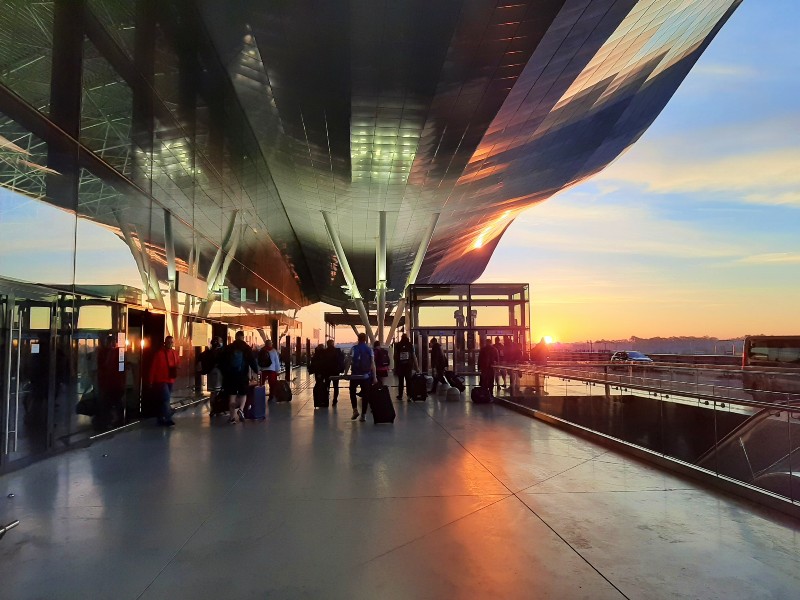
Check-in
Weirdly enough, there was no check-in desk posted for the departure of my Trade Air flight to Osijek.
After inquiring with the lady at the information counter I was told that I could check-in for my Trade Air flight at any Croatian Airlines check-in desk.
Having no baggage to check, I received my boarding pass to Osijek within a minute after I handed over my passport.
I was told that for the two subsequent flights (Osijek-Pula and Pula-Split) I had to retrieve the boarding passes at the check-in desk at Osijek Airport.
On paper it sounds like a minor inconvenience having to do so, but in reality this entire process could not have been more easy.
But more about Osijek Airport later on in this flight report!
There was no queue at security control and I was through in seconds.
After security control, you turn left to passport control for international flights and right for domestic flights, which is what I did.
The departure hall was completely deserted.
There was nobody at my designated departure gate (Gate 10, a bus gate) and even the sole café/shop had its shutters firmly closed.




Boarding
A short while later the gate agent arrived at Gate 10 and approached me, asking whether I was flying to Osijek.
He then told me that I was in luck as I would be the only passenger on the flight!
Needless to say, I was absolutely thrilled by that message. I would have my own private plane!
Even taking an airport bus down the tarmac to the plane is quite a luxurious affair when you are the only passenger on it instead of the normal sardine can feeling in such buses.
The Let L-410 was parked at the general aviation and cargo area of Zagreb Airport, which meant it was a relatively long bus ride across the tarmac to reach my plane.




On board the Let L-410 Turbolet
There are a total of 19 passenger seats on the Let L-410 Turbolet used by Trade Air.
The seats are in a 1-2 all-economy class configuration, with solo seats on the port side and duo seats on the starboard side of the plane.
There is no advanced seat assignment, so you are basically free to pick any seat you like.
Although the aeroplane which would operate my flight (OK-LRA) was built in 1989, it somehow felt like it was much older when I stepped on board.
Maybe it were the windows with their cute little sliding curtains, or perhaps the old-fashioned ‘fasten seat belts’ light in the front of the plane. In any case, the Let L-410 Turbolet isn’t your average Boeing or Airbus!
The development programme of the Let L-410 Turbolet was started in the 1960s by Czech aircraft manufacturer Let Kunovice, with the first Turbolet hitting the skies in 1969.
It basically makes the Let L-410 Turbolet a proper communist-era plane, which sort of explains those curtains on board!
In fact, Let Kunovice started working on the L-410 Turbolet on orders from the Soviet flagship carrier Aeroflot which wanted a replacement for its ageing Antonov An-2 planes.
More than a thousand Let L-410 Turbolets have been produced since 1969, with well over 350 of them still flying in over 50 countries in the world.
The Let L-410 Turbolet is most commonly found in Africa and South America due to its STOL (Short Take-Off and Landing) characteristics which allows pilots to use this plane on short and unpaved runways.
Let Kunovice, which nowadays is called Aircraft Industries, is still making these Let L-410 Turbolets to this date, with the latest version being the L-410 NG (New Generation) which first hit the production line in 2018.




Aircrew
Back to my own flight experience! When I entered the aircraft I was greeted by a male flight attendant who asked me if I could take a seat in row 3.
Gotta hate those moments when you finally have your private plane, but still cannot select your exact seat!
Of course, this probably has to do with proper weight distribution on this small turboprop and the fact that there were five airline employees on board.
Besides the male flight attendant there was also a second (female) flight attendant, two pilots in the cockpit, and another pilot (or some kind of flight engineer or instructor – I wasn’t exactly sure) seated in the first row of the plane.
The third pilot would constantly get up during the flight to talk to the two pilots, check logbooks, and listen to all communications through his headphones.
Both the third pilot and the female flight attendant would only fly with us from Zagreb to Osijek, while the other crew members would also operate the following flight legs to Pula and Split.
Although I didn’t ask, it seemed that it was all part of a regular crew rotation.
A fun fact about the Let L-410 Turbolet is that there are no cockpit doors as the cabin is only separated from the cockpit by curtains.
If you are in luck like I was on the first leg of my journey, these curtains may be kept open during the flight, meaning that you can peek a bit into the cockpit over the shoulder of the pilot.

Safety briefing
The male flight attendant held a short personal safety briefing, which basically just meant telling me where I could find the life jacket.
As the Let L-410 Turbolet cannot fly higher than 3,000 metres and the cabin is unpressurised, there is no need for oxygen masks on board – one thing less to explain to passengers during the safety briefing!

Zagreb (ZAG) to Osijek (OSI) on Trade Air
Flight C3812 – Let L-410 Turbolet – Seat 3D
Departure: 7.55am – Arrival: 8.50am
Flight time: 0h55m – Distance: 134 miles
Costs: 69 EUR for ZAG-OSI-PUY-SPU
Take-off
Moments later the flight attendant closed the door as the pilots made the last preparations for departure.
After a short taxi ride across the airport premises, we lined up for take-off at the runway.
It took some 25 seconds from the moment the pilot hit the throttle for the plane to be airborne.
As the Let L-410 Turbolet has as maximum speed of just 350 kilometres per hour, it meant that the climb up to cruising altitude was slow and gradual.
None of that did matter. It was a gorgeous day for flying and the views from the window were already brilliant
They would only get better as the day progressed.







Slavonia
Eastern Croatia’s Slavonia region is mostly flat – so you might think that flying from Zagreb to Osijek might be a tad boring when it comes to the views from the window.
This wasn’t really the case, as the scenery on this flight was much more varied than I thought, mixing forests, fields and rivers with rolling hills.
Of course, this might also have to do with the fact that the Let L-410 Turbolet flies on a relatively low altitude, which allows you to easily identify landmarks and terrain features.
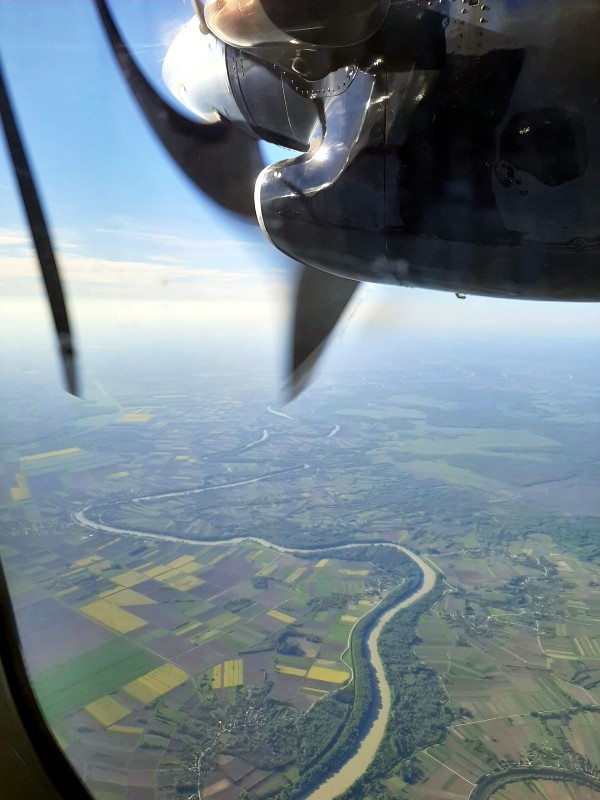






Comfort
For a small turboprop plane, the Let L-410 Turbolet is quite comfortable.
The seat pitch and shoulder room is roughly the same as you would have on any other European airline in economy class.
At not a single point during my three consecutive flights on Trade Air did I feel uncomfortable.
The only noticeable difference of these seats is that they are relatively short, which means there are no headrests.
Of course, you should not expect any luxury on board a Let L-410 Turbolet.
There are no power sockets or USB charging ports, and you can forget about on-board WiFi.
I was pleasantly surprised that on this 55 minute flight to Osijek the purser even came by with a glass of water to drink, although this seemed to be exceptionally done being the only passenger on board as on the two legs which would follow no drinks were served.
One great aspect of the Let L-410 Turbolet are the powerful individual air nozzles – they were even the old-school metal ones and not those plastic ones you’ll find on modern aircraft!
Another surprise was the fact that the plane was certainly not as noisy as I somehow expected the entire flight experience on the Let L-410 Turbolet would be.



Landing at Osijek
After a fun flight which went by rather quickly, we slowly descended for our final approach towards Osijek Airport.
The area around Osijek is as flat as a pancake and mostly consists out of agricultural fields. Still, the views from the window were absolutely lovely.








Osijek Airport
During the flight I had already asked the flight attendant about the arrival procedure at Osijek Airport.
I was told that I had to go landside to the check-in desk to pick up the boarding passes for my next two flights to Pula and Split, clear security and wait in the departure lounge.
As those flights are all operated by the same plane and crew, I could leave my hand luggage on board during the entire process.
Although the transit process at Osijek Airport might seem like a lot of hassle, in reality it is as fast and easy as it can be.
Apart from some seasonal Croatia Airlines flights and the odd Ryanair flight (currently suspended), little Osijek Airport doesn’t get much traffic at all.
Queues will therefore be completely absent, and in any case both the flight crew and Trade Air’s ground crew at Osijek Airport know that you are in transit and have to pick up a boarding pass and to re-clear security, so there is nothing to worry about the entire process.
After picking up my boarding pass, I was even told to wait in the main hall until the security checkpoint would open!
There were five or six other passengers waiting as well for the next flight to Pula, which meant that my private plane adventure would unfortunately be over on the next leg.
Osijek Airport has a landside café and a small shop after security (which also sells drinks and bottles of wine) if you want to grab some water or a quick coffee during this stop.








Osijek (OSI) to Pula (PUY) on Trade Air
Flight C3815 – Let L-410 Turbolet – Seat 3D
Departure: 9.25am – Arrival: 10.50am
Flight time: 1h25m – Distance: 242 miles
Costs: 69 EUR for ZAG-OSI-PUY-SPU
Departure
Just like deplaning, boarding at Osijek Airport simply involves walking a few feet from the terminal building to your aircraft.
The same flight attendant as on my previous flight did another safety briefing – this time in Croatian.
Afterwards he came to me saying: “I think you know the drill so I won’t repeat it again in English”.
We took off on time from Osijek Airport in the same westerly direction as we came from.
Being seated on the starboard side of the plane, I had a good view over the city of Osijek as we took off.
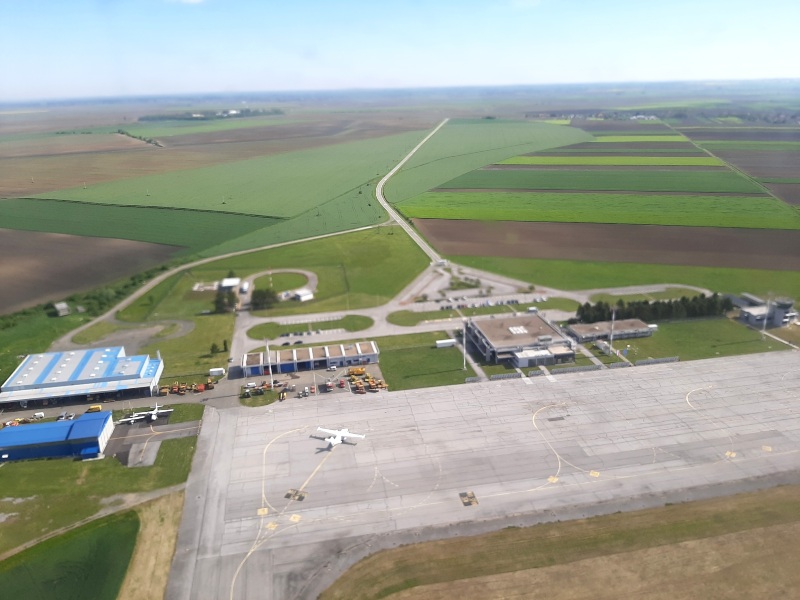


Papuk
After the fields, we flew above Park Pirode Papuk (Papuk Nature Park), which consists out of densely forested hills with Papuk being the highest at 953 metres above sea level.
It’s a gorgeous area to fly over and would probably make for great hiking territory as well.



Towns and rivers
The Osijek to Pula flight is certainly the most diverse domestic flight you can take in Croatia when it comes to seeing a great variety of landscapes from the sky.
After Papuk Nature Park, the densely forested hills give way to a more flat landscape of rivers, fields, forests and a couple of towns.
Among others, our little Let L-410 Turbolet flew over the Croatian cities of Sisak and Karlovac.







The Adriatic
After crossing Croatia’s coastal mountain range, which is part of the Dinaric Alps, the Adriatic Sea came in sight.
We took a route just to the south of the port city of Rijeka, flying over the island of Krk.
The runway of Rijeka Airport – which is actually located on Krk and not on the mainland – was clearly visible from the sky.
The views of the rugged eastern coast of Istria were drop-dead gorgeous, with the coastal mountains of Učka Nature Park forming a stunning contrast to the deep blue sea waters.








Istria
The Istria peninsula has an altogether different landscape than Croatia’s mainland.
With its green landscape of rolling hills and old hilltop towns it is often called the Croatian Tuscany.
Flying over it was unsurprisingly good for some gorgeous views as well.
By far the most beautiful part was the long coastal inlet (ria) of Raški Zaljev with its different shades of blue and purple.




Landing at Pula
After making a sharp turn left, our little Let L-410 Turbolet flew parallel to Istria’s western coast on final approach towards Pula Airport.
From my window, I had some good views over Istria’s largest and most important city and port.
Our landing at Pula Airport was smooth and again on time.
We had a parking spot on the tarmac close to the terminal, which meant that again we could all simply walk from the plane to the terminal building.





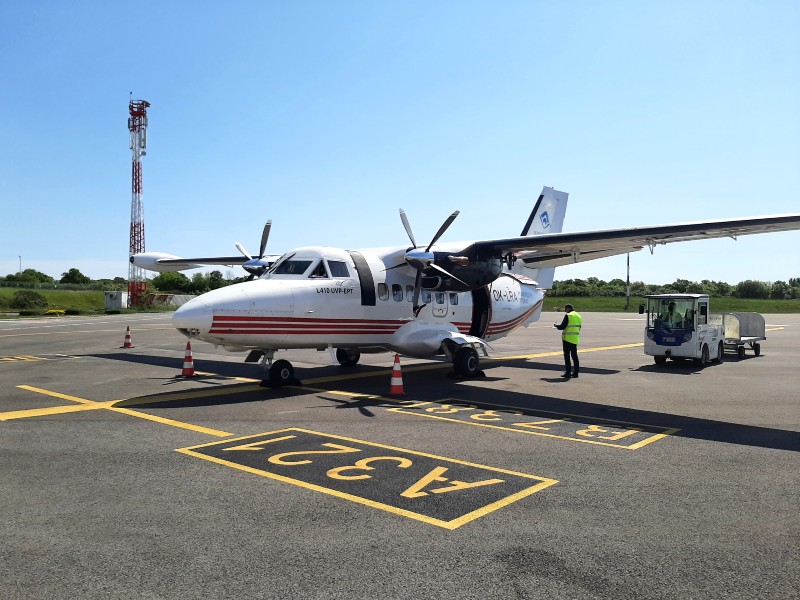
Pula transit
After disembarking the aircraft, a ground handling agent signalled that we had to follow her towards the terminal.
Passengers with Pula as their final destination can simply walk on to baggage reclaim and the exit, while passengers flying onward to Split are brought straight to the departure gate by the ground handling agent.
Fortunately, there is no security check involved when transiting through Pula Airport on your domestic Trade Air flights.
With three other passengers of my Osijek-Pula flight I waited at the gate, where moments later some five or six new passengers arrived who originated their journey in Pula and who would fly with us to Split.
Pula Airport seemed like an absolute ghost town as there were no other flight departures or arrivals around this hour and the terminal shop had its shutters closed.
Some twenty minutes later, the same ground handling agent came by again to walk us back to the plane for the next flight to Split.





Pula (PUY) to Split (SPU) on Trade Air
Flight C3815 – Let L-410 Turbolet – Seat 4A
Departure: 11.20am – Arrival: 12.15pm
Flight time: 0h55m – Distance: 150 miles
Costs: 69 EUR for ZAG-OSI-PUY-SPU
Departure
For this flight from Pula to Split I took a seat on the port side, as I knew that the best views would be from this side of the plane.
Between Pula and Split, the plan flies right over the Dalmatian islands.
Although you will also have some nice views over some islands and the open sea from the starboard side, the view from the port side will be much more spectacular as here the islands will come together with the gorgeous backdrop of the Dinaric Alps.
After take-off, we crossed the Istrian peninsula and headed in a south-easterly direction over the Adriatic Sea.






Croatian islands
Of all European countries, Croatia has probably the most amazing coast together with Greece.
Croatia has 718 islands, 389 islets and 78 reefs, which makes the Croatian archipelago the second largest in the Mediterranean area after Greece.
On the flight from Pula to Split, you fly over a large number of those islands!
Shortly after departure from Pula, the Let L-410 Turbolet flew over the islands of Cres and Lošinj, which almost seem to touch each other if it wasn’t for the narrow channel at the town of Osor.




Zadar
After Cres, the plane flies over the Kvarner Gulf towards the north Dalmatian archipelago and the coastal city of Zadar.
Here, the gorgeous backdrop of the Dinaric Alps is at its most majestic as long, stretched out islands such as Pag contrast beautifully to the coastal mountain range behind it on the mainland.
If you close your eyes for a second and forget that you are flying over Croatia, you might even think that the islands below are some kind of Micronesian or Polynesian atolls with their wonderful shades of blue.
If you sit on the port side of the plane, you will have a good view over the city of Zadar.
It’s a city which I’ve visited many times before, having some good friends living there.
According to Alfred Hitchcock, Zadar has the most beautiful sunsets in the world – and he is quite right in that.
Unfortunately, I wouldn’t have time to visit this lovely part of Dalmatia on this trip.





Lake Vrana
Another highlight of the flight from Pula to Split is the view over Lake Vrana, of which the murky blue-greenish waters contrast sharply with the clear and deep blue waters of the Adriatic Sea.






Šibenik
A few minutes after my Let L-410 Turbolet passed by the city of Šibenik and a gorgeous inlet at the town of Grebaštica, the views changed again.
This time, there was no longer a sea view from my port window as we overflew some barren, mountainous terrain.
At that point, we started our descent towards Split Airport.
If you think at this moment that there won’t be any more sea views again from the port side of the plane you are mistaken, as some of the most scenic views of all my Trade Air flights this day were yet to come.
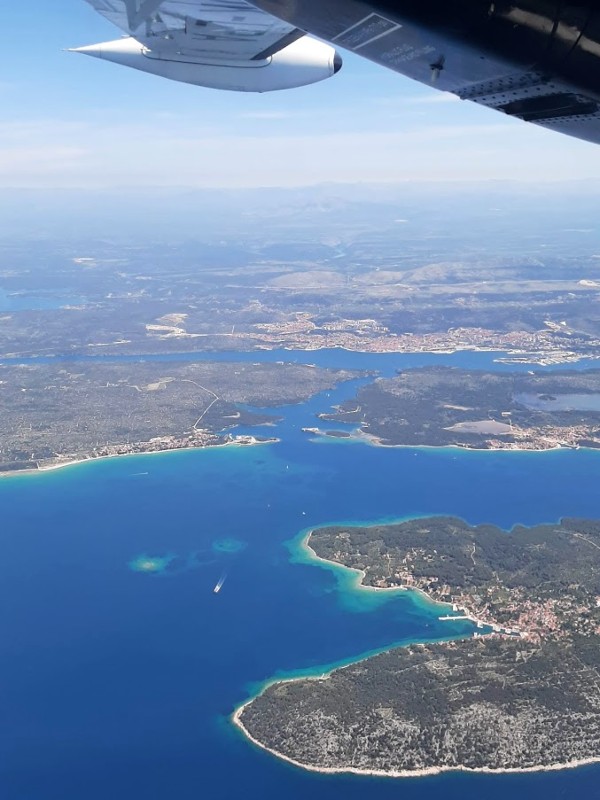




Trogir
By far the most spectacular part of the Pula to Split flight was our flyover over the old town of Trogir.
This historic city is on the UNESCO World Heritage List and would be the place where I would stay for the next couple of days.
I have always preferred landings over take-offs, especially when you fly over a city or country you haven’t visited before as it only adds to the excitement and anticipation.

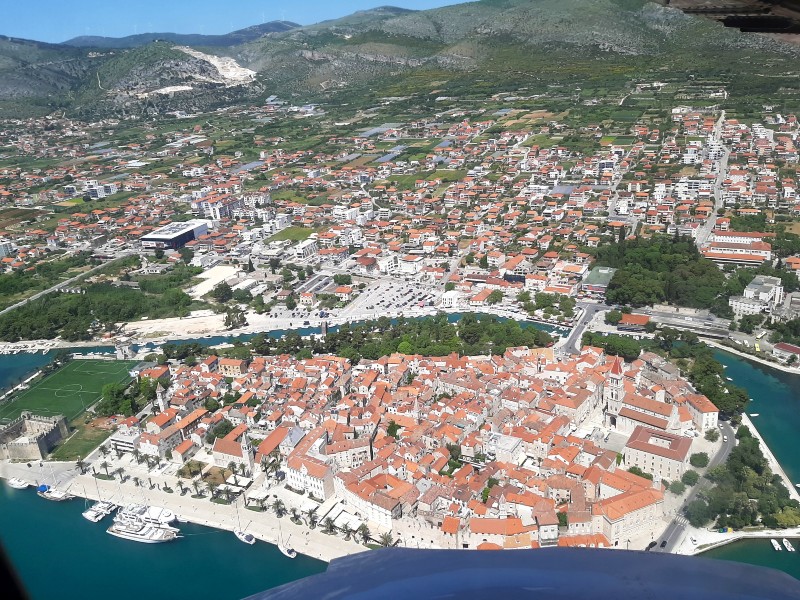

Landing at Split
At this point, we were already on our final approach towards Split Airport – which is located roughly halfway between Trogir and Split.
The Trade Air Let L-410 Turbolet landed safely and on time at Split Airport.
We had a relatively short taxi ride to the terminal, where we parked on the tarmac next to a Dash 8-400 of Croatia Airlines.
I could have taken that exact plane for a direct flight between Zagreb and Split which would have taken just 50 minutes instead of an entire morning, but I was so glad that I didn’t and was instead on this unique Trade Air flight across Croatia!
At Split Airport, we could also walk straight from the plane to the terminal.
Within five minutes after disembarkation I was already standing at the bus stop on the main road just outside the airport, waiting for my bus to Trogir to arrive.


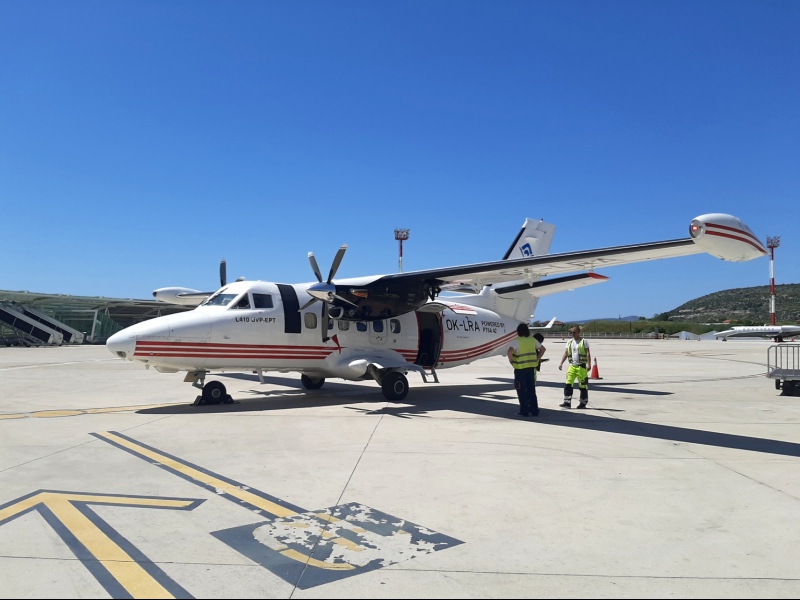


Conclusion
The Let L-410 Turbolet is an amazingly fun plane to fly and I was happy to have taken the time to hop on this unique aircraft.
Living in Europe, this small turboprop is certainly not your everday plane.
The Let L-140 has only 19 seats, a maximum ceiling of 3,000 metres and a maximum speed of 350 kph.
This is partly what makes flying the Let L-410 Turbolet so special, as due to the relatively low altitudes you are flying on there will be some amazing views from the window.
That is especially true when you fly one of the domestic Trade Air routes in Croatia on board their Let L-410 Turbolet. Croatia is such a diverse and gorgeous country!
On my Trade Air flights I saw amazing views of rolling hills, dense forests, rivers, mountains, agricultural fields, old cities and what is perhaps Europe’s most picturesque coastline.
The price for my three flights across Croatia? Just 69 euro – a fixed price as it’s a PSO route.
If you are an aviation enthusiast or just love watching the scenery down below from a plane window, then you should definitely seek out these Trade Air flights on the Let L-410 Turbolet!
Trip report index
This article is part of the ‘Across Europe by Train: Interrail in the Age of Corona‘ trip report, which consists of the following chapters:
1. Review: LOT Polish Airlines Economy Class Bucharest to Warsaw (Embraer ERJ-175)
2. Walking Through an Empty Warsaw in Corona Lockdown
3. Review: Four Points by Sheraton Warsaw Mokotow
4. Review: LOT Polish Airlines Economy Class Warsaw to Zurich (Boeing 737 MAX)
5. A Stopover Walk Through the Old Town of Zurich
6. Review: Railjet Train Zurich to Feldkirch
7. An Evening in Friendly Little Feldkirch
8. Review: Nightjet Train Feldkirch to Graz
9. A Short Walk Along the Sights of Graz
10. Review: Emona EuroCity Train Vienna – Ljubljana – Trieste
11. Zidani Most: Europe’s Most Picturesque Train Station
12. Review: Ljubljana to Zagreb by EuroCity Train EC 1211 ‘Sava’
13. Flying With Trade Air on a Let L-410 Turbolet Across Croatia (current chapter)
14. Review: Palace Derossi, Trogir, Croatia
15. A Visit to the Tranquil Island City of Trogir, Croatia
16. Cycling on Ciovo: A Trogir Day Trip by Bike
17. Split: Croatia’s Bustling Seaside City Full of History
18. Review: Croatian Railways ICN Train Split to Zagreb
19. Review: Esplanade Hotel, Zagreb, Croatia
20. Zagreb: A Guide to Croatia’s Underrated Capital City
21. Review: EuroCity Train “Croatia” Zagreb to Vienna
22. Review: Dacia Night Train Vienna to Bucharest

